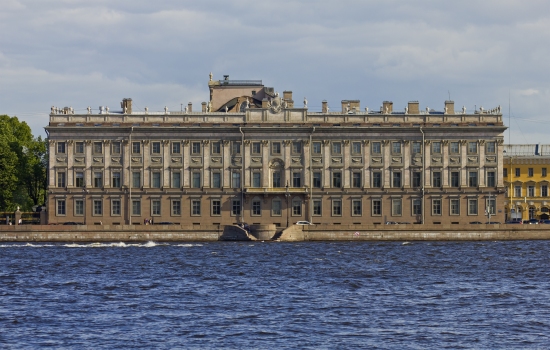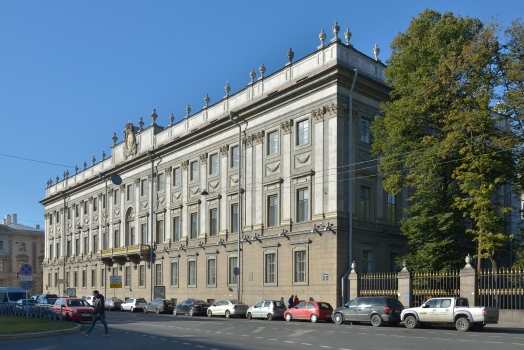General Information
Project Type
| Function / usage: |
original use: Palace current use: Museum building |
|---|---|
| Architectural style: |
Neoclassical |
Location
| Location: |
Saint Petersburg, Northwestern Federal District, Russia |
|---|---|
| Coordinates: | 59° 56' 42.58" N 30° 19' 36.03" E |
Technical Information
There currently is no technical data available.
Excerpt from Wikipedia
Marble Palace (Мраморный дворец) is one of the first Neoclassical palaces in Saint Petersburg, Russia. It is situated between the Field of Mars and Palace Quay, slightly to the east from New Michael Palace.
Design and pre-1917 owners
The palace was built by Count Grigory Orlov, the favorite of Empress Catherine the Great and the most powerful Russian nobleman of the 1760s. Construction started in 1768 to designs by Antonio Rinaldi, who previously had helped decorate the grand palace at Caserta near Naples. The combination of sumptuous ornamentation with rigorously classicizing monumentality, as practiced by Rinaldi, may be attributed to his earlier work under Luigi Vanvitelli in Italy.
The palace takes its name from its opulent decoration in a wide variety of polychrome marbles. A rough-grained Finnish granite on the ground floor is in subtle contrast to polished pink Karelian marble of the pilasters and white Urals marble of capitals and festoons. Panels of veined bluish gray Urals marble separate the floors, while Tallinn dolomite was employed for ornamental urns. In all, 32 disparate shades of marble were used to decorate the palace.
The plan of the edifice is trapezoidal: each of its four facades, though strictly symmetrical, has a different design. One of the facades conceals a recessed courtyard, where an armored car employed by Lenin during the October Revolution used to be mounted on display between 1937 and 1992. Nowadays, the court is dominated by a sturdy equestrian statue of Alexander III of Russia, the most famous work of sculptor Paolo Troubetzkoy; formerly it graced a square before the Moscow Railway Station.
Fedot Shubin, Mikhail Kozlovsky, Stefano Torelli and other Russian and foreign craftsmen decorated the interior with inlaid coloured marbles, stucco, and statuary until 1785, by which time Count Orlov had already died (1783), and the Empress had the palace purchased for her own heirs. In 1797–1798 the structure was leased to Stanisław II Augustus, the last king of Poland. Thereafter the palace belonged to Grand Duke Constantine Pavlovich and his heirs from the Konstantinovichi branch of the Romanov family.
In 1843, Grand Duke Constantine Nikolayevich decided to redecorate the edifice, renaming it Constantine Palace and engaging Alexander Brullov as the architect. An adjacent church and other outbuildings were completely rebuilt, while the interior of the palace was refurbished in keeping with the eclectic tastes of its new owner. Only the main staircase and the Marble Hall survived that refacing and still retain the refined stucco work and elaborate marble pattern of Rinaldi's original decor.
Usage during Soviet times
During the Soviet era, the palace successively housed the Ministry of Labour (1917–19), the Academy of Material Culture (1919–36), and, most notably, the main local branch of the Moscow-based Central (i.e. National) Lenin Museum (1937–91) with sub-branches across Leningrad in Lenin's memorial apartments all over the city - the places where he lived or stayed during his various periods in what was then Saint Petersburg.
Present state: a branch of Russian Museum
Currently, the palace accommodates permanent exhibitions of the Russian State Museum, notably "Foreign Artists in Russia (18th and 19th centuries)" and the "Peter Ludwig Museum at the Russian Museum", featuring canvases by Andy Warhol and other Pop Art idols.
Text imported from Wikipedia article "Marble Palace" and modified on 23 July 2019 under the CC-BY-SA 3.0 license.
Participants
- Antonio Rinaldi (architect)
Relevant Web Sites
Relevant Publications
- (2018): The roof of the Marble Palace in Saint-Petersburg: A structural iron ensemble from the 1770s. Presented at: 6th International Congress on Construction History (6ICCH 2018), July 9-13, 2018, Brussels, Belgium, pp. 809-817.
- About this
data sheet - Structure-ID
20075914 - Published on:
14/09/2018 - Last updated on:
27/05/2021






